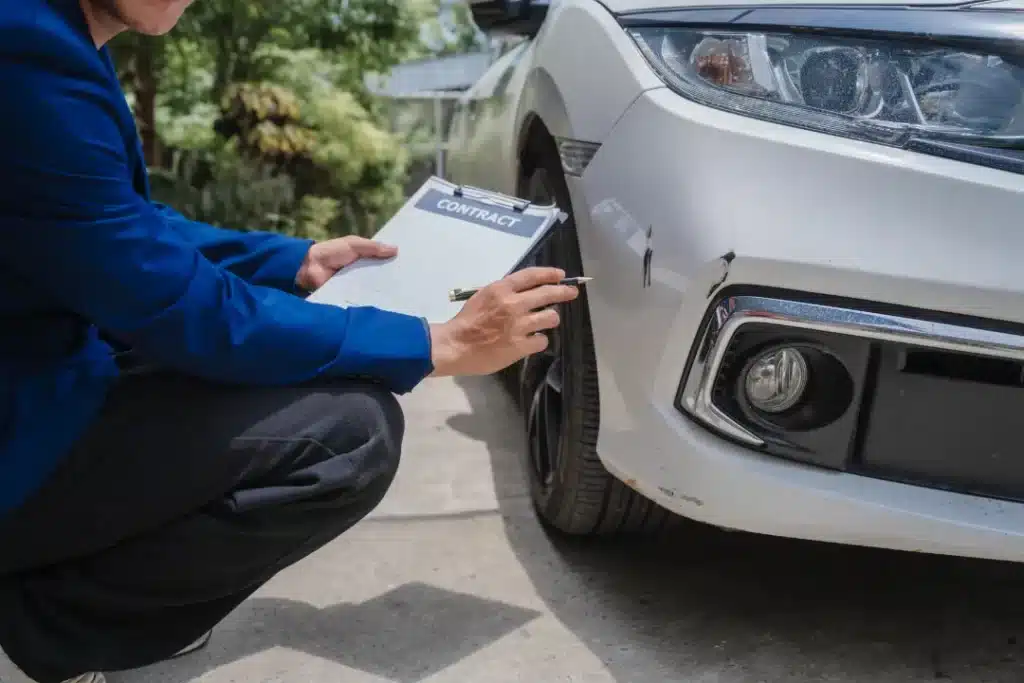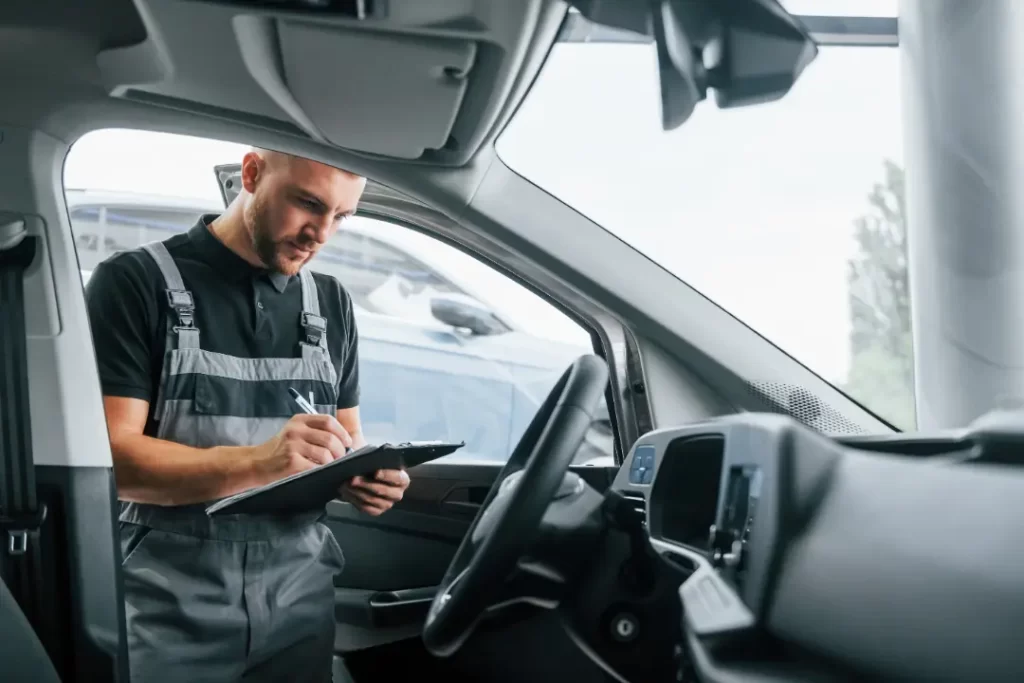Don’t risk failing your MOT. Before the test, check these crucial areas: lights, tyres, brakes, and fluids. This guide on things to check before MOT will help you avoid common issues and ensure your car is ready.
Key Takeaways
- Perform essential pre-MOT checks on lights, tyres, brakes, and wipers to increase the likelihood of passing.
- Ensure all vehicle documentation, including the VIN and V5C logbook, is accurate and accessible to avoid inspection complications.
- Understand common MOT failure categories and repair options to effectively address issues and retest your vehicle promptly if necessary.
Essential Pre-MOT Checks
Pre-MOT checks can improve your chances of passing and help save both time and money. Common issues include faulty windscreen wipers, insufficient tyre tread depth, and non-working bulbs. Addressing these issues beforehand can significantly lower the risk of failure.
Key areas to focus on include lights and indicators, tyres and wheels, brakes, and windscreen and wipers.

Lights and Indicators
One of the most common reasons for MOT failures is when a vehicle fails due to faulty lighting.
To avoid this, ensure all lights are functioning correctly, including:
- Headlights
- Sidelights
- Brake lights
- Rear lights
- Hazard lights
- Indicators
A simple way to check your brake lights is to press the brake pedal and have someone verify their operation or reverse into a reflective surface.
Check for blown bulbs and replace them. Operational lights not only help pass the MOT but also ensure vehicle safety, especially at night or in adverse weather.
Tyres and Wheels
Tyres and wheels are crucial to inspect. Ensure tyres have a minimum tread depth of 1.6mm and are free of lumps, bulges, and cracks. About 10.4% of MOT test failures are tyre-related. Make sure tyres are in good condition, properly inflated, and meet legal tread depth requirements.
Check the tyre pressure monitoring system if it is available. Proper tyre maintenance helps pass the MOT, improve fuel efficiency, and ensure safer driving.
Brakes and Brake Pedal
Brake issues are common in MOT failures. Check the brake disc surface and pad thickness. Squealing or grinding sounds indicate worn brake pads. Also, ensure the car stops in a straight line; pulling to one side suggests a brake issue.
Regular brake checks can prevent unexpected failures and ensure vehicle safety. Brake issues comprise a significant percentage of MOT defects.
Windscreen and Wipers
A clear windscreen and functioning wipers are vital. Damage over 10mm in the driver’s view or larger than 40mm elsewhere can lead to failure.
Ensure wipers are free from tears or holes; significant damage can cause failure. Also, keep the screen wash topped up, as an empty wash bottle can lead to failure.
Windscreen wipers are essential for a clear view while driving.
Engine and Fuel System
Detailed engine checks can prevent unexpected failures. Regular inspections of engine components can reduce the likelihood of MOT failure.
Proper maintenance of the engine and fuel system is crucial for passing the MOT.
Engine Oil and Fluids
Fuel and engine oil are needed to test emission levels. Inadequate levels may lead to rejection. Ensure these levels are suitable before inspection. Also, check all fluids, including coolant, brake, and power steering fluids, for correct levels and leaks.
Regular fluid checks can prevent potential issues and ensure smooth vehicle operation, saving you from the inconvenience and costs of a failed MOT.
Fuel Cap and Fuel System
The fuel cap must close properly to prevent leaks and create a proper seal to avoid fuel evaporation. Ensuring a secure closure is essential for compliance.
Inspect the fuel system for damage to avoid MOT failures. Regular maintenance ensures optimal performance and reduces the risk of issues.
Vehicle Identification and Documentation
Proper documentation and vehicle identification are crucial. The vehicle must display a clear and legible VIN. The V5C logbook holds essential information about the vehicle.
Accurate documentation avoids discrepancies during the MOT inspection.

Vehicle Identification Number (VIN)
The VIN must be clearly visible for inspection. Ensure it matches the number on the car’s bodywork and the vehicle’s legal documentation.
The VIN verifies the car’s identity during the MOT process.
MOT Certificate and V5C Document
Essential documents for the MOT test include the V5C registration document and the current valid mot certificate. Present both at the test centre to avoid issues. If lost, the V5C logbook can be replaced online through the DVLA with the vehicle’s registration and VIN.
Correct documentation ensures a smooth MOT process and avoids delays or complications.
Bodywork and Mirrors
Inspect the car’s bodywork for sharp edges, excessive corrosion, or damage. Mirrors must be intact, securely attached, and provide a clear view of the road.
Car’s Bodywork
The car’s bodywork should not have sharp edges that pose a danger. Ensure all body panels are securely attached and free from significant dents or deformities.
Your car’s bodywork must meet safety standards to pass the MOT.
Mirrors and Visibility
All mirrors should be securely attached to prevent them from falling off. They must provide a clear view of the road and surroundings. Both door mirrors and the rear-view mirror must be intact, adjustable, and unobstructed.
Mirrors should be free of cracks or damage that hinder visibility, a common MOT failure reason. Ensuring all mirrors are securely fixed and provide a clear view is essential for safe driving.
Exhaust System and Emissions
The exhaust system controls vehicle emissions and must be in good condition for the MOT. An intact and functioning exhaust system is essential for passing the MOT and meeting emission standards.
Exhaust System
Check for rust or damage on exhaust components, as these can indicate potential failures. The exhaust should be securely mounted to prevent movement that could cause damage or noise.
Inspecting the exhaust system ensures compliance with emission standards and avoids unexpected failures.
Emission Levels
Vehicles must adhere to emission limits set by the manufacturer, especially those used after 2002. Failing to meet these standards can result in an MOT failure. Cars must pass emission tests, often requiring a check of the catalytic converter.
A malfunctioning engine light can indicate issues leading to increased emissions and potential MOT failure. Meeting emission standards is critical for passing the MOT and maintaining environmental compliance.
Steering and Suspension
Proper steering and suspension ensure smooth handling and vehicle safety. Regular inspections of suspension components affect vehicle stability and comfort.
Steering Wheel and Power Steering
The steering wheel and column’s condition is critical for safe operation. The steering wheel should have minimal play for accurate handling. Ensure the power steering system functions correctly for safe driving.
Regular inspections of steering components can identify issues early and prevent unexpected MOT failures.
Shock Absorbers and Suspension
Inspect shock absorbers for leaks and ensure they are securely attached for proper damping. Signs of wear in suspension parts can be detected through visual and physical assessments. Regular suspension checks maintain vehicle stability and comfort.
Faulty shock absorbers and snapped springs might be hard to notice. Ensuring the suspension system is in good condition is essential for passing the MOT and ensuring a smooth ride.
Seat Belts and Seats
Seat belts restrain occupants during a collision, ensuring passenger safety. The driver’s seat must be adjustable, moving forwards and backwards, and securely attached.
Seat Belts
Ensure seat belts are in good working order for the MOT. Check for fraying and proper engagement. Cuts or fraying indicate failure. Test by pulling sharply on each belt to check their reaction.
Regular checks and tests ensure seat belts function correctly, increasing safety. Consistent maintenance can prevent MOT failures and ensure passenger safety.
Driver’s Seat and Adjustment
The driver’s seat should move forwards and backwards freely. Check the seat adjusts as required. A properly adjustable seat ensures driver comfort and road visibility.
Ensure the driver’s seat is securely fixed to avoid movement while driving. Regular checks of the seat and its adjustments significantly contribute to occupant safety.
What to Do If Your Car Fails Its MOT
A failed MOT isn’t the end. Nearly half of all failures are due to basic maintenance issues. Understanding MOT failure categories and repair options can help get your vehicle back on track.

Understanding MOT Failure Categories
MOT failure faults are classified as minor, major, and dangerous. Minor faults should be fixed promptly, while major faults can be repaired at another garage. Dangerous faults require immediate repairs, and the vehicle cannot be used until fixed. A VT30 certificate is issued for failed MOTs, indicating specific faults.
Understanding these categories and addressing issues promptly can avoid complications and ensure your vehicle remains roadworthy.
Repair Options and Retesting
If your car fails the MOT test, you may be eligible for a free retest if repairs are completed at the original testing centre within ten working days. Partial retests may be conducted, but not all repairs may qualify.
Knowing your repair options and free retest conditions can save money and ensure your vehicle passes the MOT without delays.
Trust Sovereign Motor Engineers for Your MOT Needs
At Sovereign Motor Engineers, we understand how stressful MOT preparations can be. That’s why we’re here to make the process seamless and hassle-free for you. Our expert team offers comprehensive MOT inspections to ensure your vehicle is roadworthy and ready to pass. Whether it’s checking lights, brakes, tyres, or the engine, we handle it all with care and precision. Let us save you the time and worry of potential MOT failures with our thorough and reliable service.
When you choose Sovereign Motor Engineers, you’re not just getting a service; you’re gaining a partner who genuinely cares about your vehicle’s safety and performance. Our highly skilled technicians go above and beyond to identify and fix issues, ensuring your car meets all legal and safety standards. Drive with confidence, knowing your vehicle is in the hands of trusted experts.
Expert Vehicle Diagnostics and Repairs
If your car needs repairs or diagnostics, Sovereign Motor Engineers is your go-to destination. We specialise in pinpointing and resolving issues quickly, minimising downtime and getting you back on the road. We uncover problems that others might miss using advanced diagnostic tools, ensuring a long-lasting solution. From engine troubles to suspension issues, no job is too big or small for our dedicated team.
What sets us apart is our commitment to quality and transparency. We keep you informed every step of the way so you’re never left wondering about the condition of your vehicle. With competitive pricing and a customer-first approach, you can trust us to deliver exceptional results every time.
Reliable MOT Testing and Comprehensive Vehicle Care
Sovereign Motor Engineers offers professional MOT testing services that prioritise both efficiency and accuracy. Our certified testers thoroughly assess every aspect of your vehicle, providing honest feedback and actionable advice. If repairs are needed, we’ll handle them promptly to ensure your vehicle is safe and compliant with all regulations.
Beyond MOTs, we provide a full range of vehicle care services, from routine maintenance to detailed inspections. We treat every car as if it were our own, ensuring it operates at peak performance. Choose Sovereign Motor Engineers for a seamless, stress-free experience that prioritises your safety and satisfaction.
Frequently Asked Questions
What are the most common reasons for MOT failures?
MOT failures commonly result from faulty windscreen wipers, insufficient tyre tread depth, non-working bulbs, and brake issues. Addressing these areas can help ensure your vehicle passes the inspection.
What documents do I need to present for the MOT test?
You need to present the V5C registration document and the current MOT certificate for the MOT test. Having these documents ready will streamline the process for you.
What should I do if my car fails the MOT?
If your car fails the MOT, reviewing the failure categories, repairing the identified issues, and scheduling a retest is essential. This proactive approach ensures your vehicle meets safety and emissions standards.
How can I check if my brake lights are working?
To check if your brake lights are working, press the brake pedal and ask someone to confirm their operation, or reverse your vehicle next to a reflective surface to see if the lights activate.
Why is it important to check the fuel cap before the MOT?
It’s crucial to check the fuel cap before the MOT to prevent fuel leaks and ensure the vehicle meets compliance standards. A secure seal contributes to overall safety and environmental responsibility.
Conclusion
Preparing for your annual MOT test with a thorough pre-MOT checklist can significantly improve your chances of passing and prevent an MOT fail. From checking lights and indicators to ensuring proper documentation and maintaining your engine and fuel system, every step is crucial. Regular maintenance and attention to detail can help you avoid common issues that lead to MOT failures.
Remember, a well-maintained vehicle isn’t just about passing the MOT; it’s about ensuring your safety and the safety of others on the road. By following these essential tips, you can drive confidently, knowing your car is in top condition.

